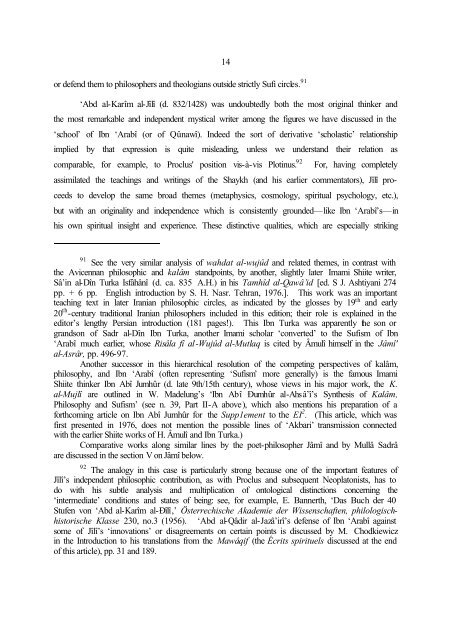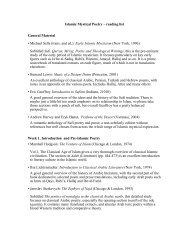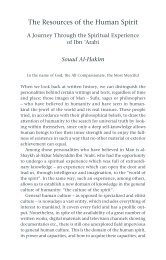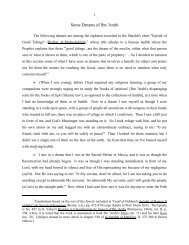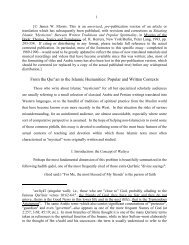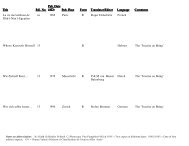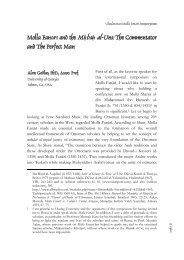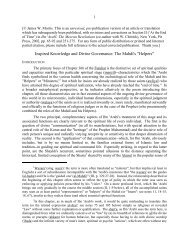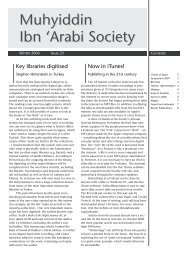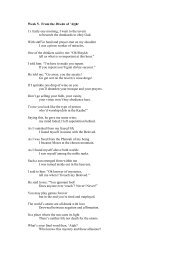Part III (pdf) - Muhyiddin Ibn Arabi Society
Part III (pdf) - Muhyiddin Ibn Arabi Society
Part III (pdf) - Muhyiddin Ibn Arabi Society
You also want an ePaper? Increase the reach of your titles
YUMPU automatically turns print PDFs into web optimized ePapers that Google loves.
14or defend them to philosophers and theologians outside strictly Sufi circles. 91‘Abd al-Karîm al-Jîlî (d. 832/1428) was undoubtedly both the most original thinker andthe most remarkable and independent mystical writer among the figures we have discussed in the‘school’ of <strong>Ibn</strong> ‘Arabî (or of Qûnawî). Indeed the sort of derivative ‘scholastic’ relationshipimplied by that expression is quite misleading, unless we understand their relation ascomparable, for example, to Proclus' position vis-à-vis Plotinus. 92 For, having completelyassimilated the teachings and writings of the Shaykh (and his earlier commentators), Jîlî proceedsto develop the same broad themes (metaphysics, cosmology, spiritual psychology, etc.),but with an originality and independence which is consistently grounded—like <strong>Ibn</strong> ‘Arabî’s—inhis own spiritual insight and experience. These distinctive qualities, which are especially striking91 See the very similar analysis of wahdat al-wujûd and related themes, in contrast withthe Avicennan philosophic and kalâm standpoints, by another, slightly later Imami Shiite writer,Sâ’in al-Dîn Turka Isfâhânî (d. ca. 835 A.H.) in his Tamhîd al-Qawâ’id [ed. S J. Ashtiyani 274pp. + 6 pp. English introduction by S. H. Nasr. Tehran, 1976.]. This work was an importantteaching text in later Iranian philosophic circles, as indicated by the glosses by 19 th and early20 th -century traditional Iranian philosophers included in this edition; their role is explained in theeditor’s lengthy Persian introduction (181 pages!). This <strong>Ibn</strong> Turka was apparently the son orgrandson of Sadr al-Dîn <strong>Ibn</strong> Turka, another Imami scholar ‘converted’ to the Sufism of <strong>Ibn</strong>‘Arabî much earlier, whose Risâla fî al-Wujûd al-Mutlaq is cited by Âmulî himself in the Jâmî'al-Asrâr, pp. 496-97.Another successor in this hierarchical resolution of the competing perspectives of kalâm,philosophy, and <strong>Ibn</strong> ‘Arabî (often representing ‘Sufism’ more generally) is the famous ImamiShiite thinker <strong>Ibn</strong> Abî Jumhûr (d. late 9th/15th century), whose views in his major work, the K.al-Mujlî are outlined in W. Madelung’s ‘<strong>Ibn</strong> Abî Ðumhûr al-Ahs â’î’s Synthesis of Kalâm,Philosophy and Sufism’ (see n. 39, <strong>Part</strong> II-A above), which also mentions his preparation of aforthcoming article on <strong>Ibn</strong> Abî Jumhûr for the Supp1ement to the EI 2 . (This article, which wasfirst presented in 1976, does not mention the possible lines of ‘Akbari’ transmission connectedwith the earlier Shiite works of H. Âmulî and <strong>Ibn</strong> Turka.)Comparative works along similar lines by the poet-philosopher Jâmî and by Mullâ Sadrâare discussed in the section V on Jâmî below.92 The analogy in this case is particularly strong because one of the important features ofJîlî’s independent philosophic contribution, as with Proclus and subsequent Neoplatonists, has todo with his subtle analysis and multiplication of ontological distinctions concerning the‘intermediate’ conditions and states of being: see, for example, E. Bannerth, ‘Das Buch der 40Stufen von ‘Abd al-Karîm al-Ðîlî,’ Österrechische Akademie der Wissenschaften, philologischhistorischeKlasse 230, no.3 (1956). ‘Abd al-Qâdir al-Jazâ’irî’s defense of <strong>Ibn</strong> ‘Arabî againstsome of Jîlî’s ‘innovations’ or disagreements on certain points is discussed by M. Chodkiewiczin the Introduction to his translations from the Mawâqif (the Écrits spirituels discussed at the endof this article), pp. 31 and 189.


